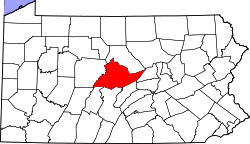Nittany Valley | |
|---|---|
Region | |
 Aerial photo of Nittany Valley looking east from Bellefonte, Pennsylvania, with Bald Eagle Mountain on the left and the back ridge of Mount Nittany in the upper right | |
 | |
| Country | United States |
| State | Pennsylvania |
| County | Centre |
| Elevation | 1,154 ft (352 m) |
| Population (2010) | |
• Total | 25,502 |
| Time zone | UTC-5 (EST) |
| • Summer (DST) | UTC-4 (EDT) |
| Zip | 16823 |
| Area code | 814 |

Nittany Valley is an eroded anticlinal valley [1] located in Centre County, Pennsylvania. It is separated from the Bald Eagle Valley by Bald Eagle Mountain and from Penns Valley by Mount Nittany. The valley is closed to the north by a high plateau that joins these two mountain ridges, but is open to the south at the southern terminus of Mount Nittany. The valley drains to Bald Eagle Creek through water gaps in Bald Eagle Mountain formed by Spring Creek and Fishing Creek, along with smaller streams running through Curtain Gap and Howard Gap. The northwest side of the valley between the Bald Eagle Mountain ridge and the lower Sand Ridge is also known as the Little Nittany Valley.
Contents
The valley has a mixture of farmland, woodlots, and several working and abandoned quarries. Bellefonte, the county seat of Centre County, is the largest municipality completely within the valley. The Pennsylvania State Correctional Institution - Rockview, the Nittany Mall, the Pennsylvania Transportation Institute and University Park Airport are large facilities located in the valley. State College, Pennsylvania and the Pennsylvania State University main University Park campus lie at the southern end of the Nittany and Penns Valleys, and this area is also known as "Happy Valley".